April 30, 2008
Stained Glass - on a License Plate
News today that Florida will likely not approve the idea of a Christian themed license plate.
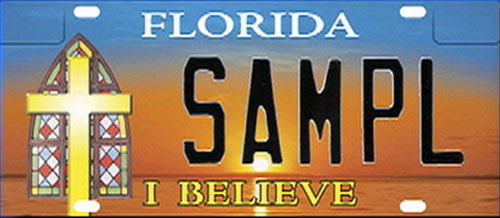
I'm more or less indifferent regarding the idea of a Christian themed license plate.
My problem is this - I don't like to see the image of a stained glass window used as a generic symbol for religion. I see it all the time, and I don't like it. If you must, think of it as my own call for 'brand protection'. I do not want stained glass shown as inherently or exclusively religious.
I was raised a Christian, specifically a Lutheran, but the particular church building I knew as a child did not have stained glass. My parents were not overly religious, neither were they interested in religious art, so we never made a practice of visiting other churches. Therefore, I never developed the notion of "stained glass equals religion".
I became interested in stained glass through the arts & crafts movement of the 1960's, specifically through seeing it for the first time at the Guilford Handicraft Festival, now the Guilford Craft Expo, in Guilford CT. Here, and for the 10 or so years after I first became interested in stained glass, I came across no subject matter specifically related to religion.
In the many years of working in the field of stained glass as a professional, I've grown to know, love and admire religious stained glass. I've met and known colleagues in the field who work in stained glass primarily because of their faith and I can respect that. I've worked on many religious stained glass windows in studios over the years, and have designed and fabricated some on my own.
Nevertheless, I still don't think of stained glass inherently, and certainly not exclusively, as a religious art. Instead, I see stained glass as a unique combination of materials and techniques that makes for especially striking, dramatic, colorful and beautiful artwork. I'm content with that.
I suppose my fear is that if more and more people associate stained glass exclusively with religion, the less stained glass will be seen as appropriate for public or commercial situations, or even for non-religious personal commissions.
I don't remember this practice of using the stained glass window as a generic symbol for religion being so pervasive 20 years ago. Was I just not noticing it as much then? Or am I just bothered by it more as I get older?
Whatever the answer, I say to Florida, if you must have a Christian themed license plate, fine - just please leave off the stained glass window.
Oddly enough, I came upon this story in yet another reference to stained glass on The Colbert Report. The world gets curiouser and curiouser...
| The Colbert Report | Mon - Thurs 11:30pm / 10:30c | |||
| The Word - Separation of Church & Plate | ||||
| ||||
[update, June 21, 2008 - Florida may not be doing it but South Carolina has approved the idea, inspiring even more satirical articles.]
April 29, 2008
Nine Views of Springtime
Saw this first on a Fox & Clover Flickrset
Nature themes. Illustrative. Simple, straightforward. Nice.
Cloud Trees
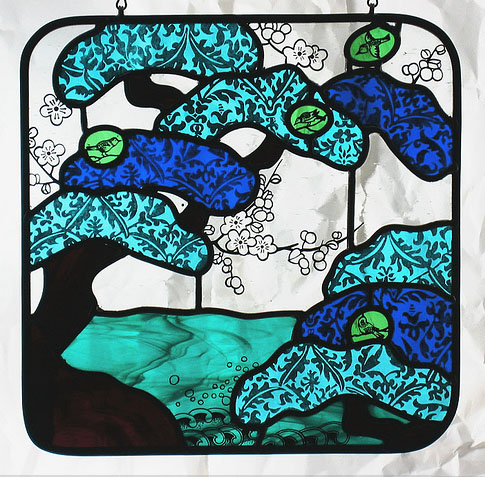
In the Flowers
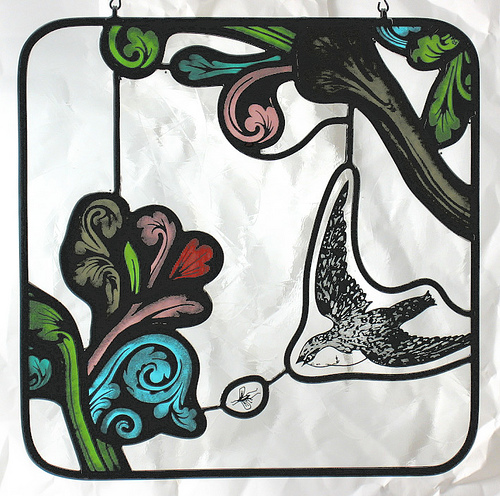
April 22, 2008
What is Art?
A curious comic interlude.
Nothing about stained glass.
Still, stained glass is art, and what is art?
April 21, 2008
Stained Glass Brains
An interview with Dr. Jill Bolte Taylor, where she explains why she creates Stained Glass Brains. File under 'stained glass as self-reflexive art therapy'.
[update May 2, 2008 - Dr. Jill Bolte Taylor was named #41 in TIME magazine's 100 most influential people. No mention of the stained glass.]
April 18, 2008
Verriere de St. Just Videos
Videos related to the Cylinder Process of making hand blown sheets of glass.
I wasn't able to embed these videos, so they may or may not work when you click on the link. It should open windows media player and play within that.
The first video shows the process for Basic Hand Blown Cylinder Glass.
The second video covers the techniques for making specialty glass, like
Dalle De Verre, Crackle Glass, Hammered, Reamy, Flashed Glass and Streaky Glass.
The other early process, which I wish I could find a video of, is the Broad Sheet Process. The broad sheet is similar to the cylinder method, except that in broad sheet the cylinder is smaller and is split and flattened while still hot.
April 16, 2008
Crown Glass Videos
A video demonstrating the making of 'Crown Glass', likely the most ancient method of making 'sheets' of flat glass.
The most surprising part of this is the shape of the piece just before 'spinning out'. I would have thought it to be rounder rather than so flat. Interesting.
The video comes from the anthropologist and historian Alan Macfarlane whose studies include the study of materials and how they affect the development of societies. The Alan Macfarlane website includes videos showcasing the impact of glass spectacles and glass windows on the development of western society, and there are even more glass related videos on his youtube area under the avatar ayabaya.
A few more crown glass related bits and pieces below the fold...
Crown Glass Images
The following images are from a PDF file on 'Industrial Vernacular'. I put them up here mainly to show how much larger crown glass can be. I've heard of them up to 4 feet in diameter, with most being around 3 feet in diameter.
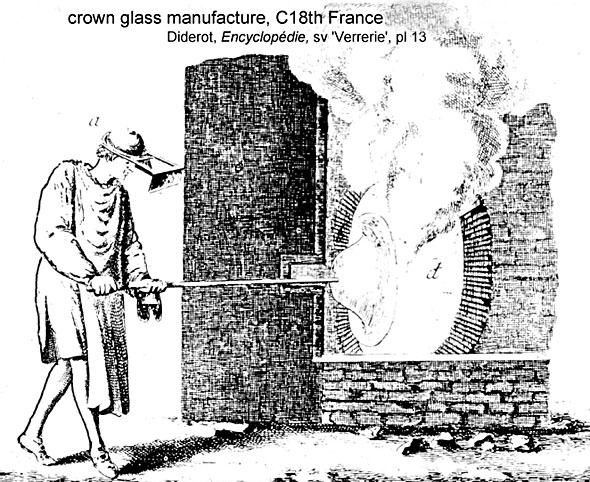
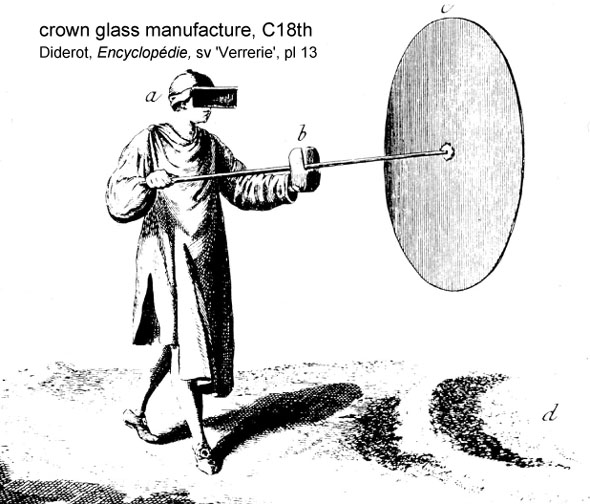
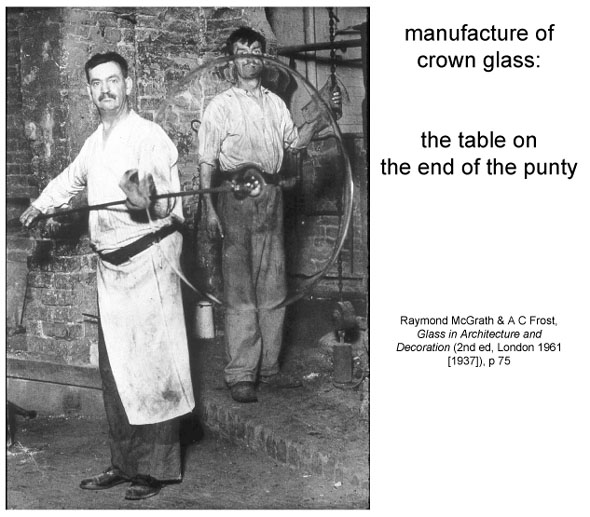
The larger size is related to the fact that these were made for the window glass. Since crown glass was a method of making window glass, the middle of the crown known as the bullseye, was considered a cheap by-product. Nowadays, since so little crown glass is manufactured, the bullseye is more valued than the flat glass surrounding it.
"Crown Glass" Today
Very few glass shops make crown glass today. One, the London Crown Glass, has a webpage featuring historical window glass manufacturing processes. No video, alas. Another company that produces some crown glass is English Antique Glass, out of Birmingham in England.
I did find this recent video of a contemporary small glass-blowing studio making a 'plate', in much the same manner that the crown glass is made. I can't help but observe that while this studio has more gadgets to play with (gas jets, rolling blowpipe holders, etc) and eager assistants to help there is not a clear sense of what they are doing, at least compared to the glassblower in the Mafarlane video.
Glass blowing dudes make a 'plate' -
In terms of big name glass artists, I can't help but notice that Chihuly's Macchia are just large colorful, textured crown glass pieces, except that the piece is held down just after being spun out and allowed to slump into the 'macchia' shape.
I know that stained glass artists such as Narcissus Quagliata and Dick Weiss have commissioned rondels, sometimes large rondels, to be incorporated into their windows and screens. Rondels are basically the same as crown glass though on a smaller scale and with no intention of cutting the piece apart.
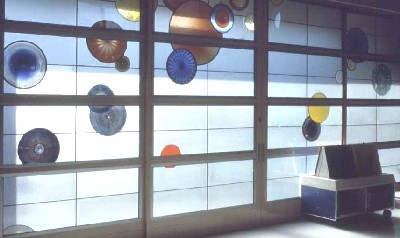
Emeryville Child Development Center, Emeryville, CA, 1991
by Narcissus Quagliata
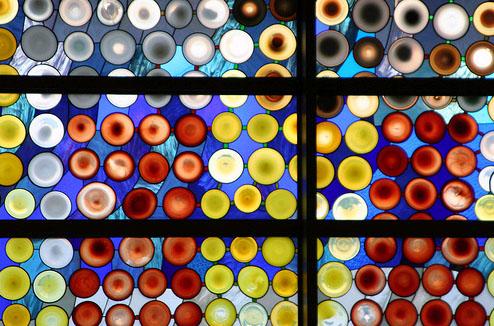
Cow on its Side, Seattle-Tacoma International Airport
by Dick Weiss
I don't know of any stained glass artists who have commissioned glass blowers to create crown glass - colored, textured or otherwise - with the intention of the glass being cut up for stained glass windows. I suppose the handblown object these days seems too precious an object to cut up.
There are lots of small hot glass shops springing up across the US and I would love to see one of these hot shops start to experiment with making crown glass for the stained glass artist, or at least larger rondels that could produce some interesting results if cut up and incorporated into panels.
A Personal View
In preparing for the Glass Art Society Conference in 2006, I worked with a glassbloweer in trying to make specialty rondels that I was thinking of as mini-crown glass pieces. My intention was to cut them up and make some small panels with them. This was the first example - only about 5 inches across.
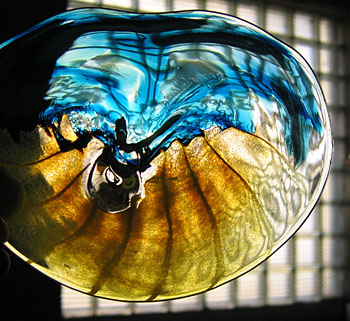
The process was interesting to watch and I can see where it would take considerable practice to get the rondel big enough to be usable as crown glass, especially when variagated color is factored in.
And yes, I can personally attest to how difficult a decision it is to cut it up. As it is, we ran out of time and I only have a few of these, and I have not yet come up with a good enough design that would justify cutting them up.
April 07, 2008
Float Glass Video
Modern Clear Sheet Glass is called 'float glass' because it's created by literally floating a ribbon of molten glass on a bed of molten tin.
This is an interesting and informative video on the making of float glass though, curiously, it does repeat the myth of glass as a super-cooled liquid that will flow over time, making antique windowpanes thicker at the bottom.
The video was shot at the Pilkington company, who received the patent for float glass in 1959.
Float glass is rarely used in stained glass windows. It's considered too uniform in appearance and therefore too cheap looking. I know of some studios that only use it for heavily painted, stained and enameled pieces. They like the toughness of the glass and the fact that there is no machine or handblown texture to show through - and the cheap price doesn't hurt either. Note that if you do paint on float glass, you must be aware that enamel paint and silver stain react differently on the 'tin side' compared to the 'non-tin side'. The tin side is the side which was in contact with the tin in the process of floating the glass, and this tin will dull colors, especially transparent enamels. For instance, a nice gold pink transparent enamel could end up a rusty red instead. Unfortunately, you can only tell which is the tin side by looking at each side using ultraviolet light.